World's Largest "Shooting Brake" Archive (Part 1 of 3)
- Story Cars

- Sep 20, 2021
- 27 min read
Updated: Nov 4, 2024
The auto industry hasn't a single universal definition for a "shooting brake." Long story short, there's confusion between what constitutes a "shooting brake" from a stations wagon, 2+2, coupe, hatchback, sports wagon, etc. So, this article was inspired by the hopes of settling the confusion and informing enthusiasts about the history and evolution of these automotive body styles that began as horse-drawn vehicles.
Let's start with the history:

1875 Engraved Illustration of Shooting Brake
Like many early automotive body styles, the shooting brake was initially a type of horse-drawn vehicle. A brake was originally a heavy drag chassis with slowing capability hooked to spirited horses. The term brake later became broader in definition, being used for wagons in general.
The shooting brake, which began in England in the 1890s, was a wagon (more specifically a type of wagonette) designed to transport hunting spoils, gun racks, and ammunition on shooting trips. However, as depicted above, the term dates even further back to (at least) 1875. Regardless, this term was well-founded in the mid-to-late 19th century.

A 1903 horse-drawn "Shooting Brake" (photo from the New York Fish & Game Commission)
The first automotive shooting brakes were manufactured in the early 1900s in the United Kingdom. The vehicle style became popular in England during the 1920s and 1930s. They were produced by vehicle manufacturers or as conversions by coachbuilders. The term was used in Britain interchangeably with estate cars from the 1930s.
Ultimately, the term has evolved to describe cars combining elements of both station wagon and coupé body styles, with or without reference to the historical usage for shooting parties. Having yet to see an operational definition of "shooting brake," the chart below is a statistical analysis of 30 official definitions of "shooting brake" and the significance of characteristics by the percentage of times listed in said definitions.
There's a statistically backed chart for the first time in history in which significant characteristics are deductible. In plain terms, a "shooting brake" is most commonly a two-door station wagon (or estate) that is long, sleek, spacious, and sporty. However, Story Cars weren't present in 1875 to truly provide a definition; this is what the internet and ebooks offer. For the sake of this article being the "The World's Largest Shooting Brakes Archive," some four-doors will be included because their official manufacturer/coachbuilder's title specifies that it was indeed a "shooting brake."
The Shooting Brake Archive
Part 1
1890 French Hunting Break by Faurax
1890 Beaufort-Style Shooting Brake
1896 Kinross Wagonette Break
1907 Rolls-Royce Silver Ghost Shooting Brake
1908 Rolls-Royce Silver Ghost Shooting Brake
1910 Rolls-Royce Silver Ghost Shooting Brake
1919 Windovers Shooting Brake
1923 Rolls-Royce Silver Ghost Shooting Brake
1924 Daimler 57HP Shooting Brake
1924 Delage DI Eight-Lite Shooting Brake
1924 Rolls-Royce Silver Ghost Shooting Brake
1924 Rolls-Royce 40/50HP Silver Ghost Shooting Brake
1926 Rolls-Royce 20HP Shooting Brake
1926 Rolls-Royce Phantom I Shooting Brake
1926 Rolls-Royce 20HP Shooting Brake
1926 Rolls-Royce 20HP Shooting Brake (GOK9)
1927 Rolls-Royce 20HP Shooting Brake (GRJ70)
1927 Wilkinson Phantom I Shooting Brake
1927 Rolls-Royce 20HP Shooting Brake (A. A. McCloud & Sons)
1927 Rolls-Royce 20HP Shooting Brake
1928 Rolls-Royce 40/50HP Phantom 1 Shooting Brake
1929 Rolls-Royce 20/25HP Shooting Brake (Henry Binder)
1929 Rolls-Royce 20HP Shooting Brake (Alpe & Saunders)
1929 Rolls-Royce 20HP Shooting Brake
1930 Rolls-Royce 20/25HP Shooting Brake
1930 Rolls-Royce Phantom II Shooting Brake
1931 Rolls-Royce 20/25HP Shooting Brake
1932 Rolls Royce 20/25HP Shooting Brake
1932 Rolls-Royce 20/25HP Shooting Brake
1933 Rolls-Royce 20/25HP Shooting Brake
1933 Rolls Royce 20/25HP 'Woodie' Shooting Brake
1934 Bentley 3 1/2 Liter Shooting Brake
1934 Rolls Royce 20/25HP 'Woody' Shooting Brake
1934 Ford "Strathglass" Estate Wagon
1935 Rolls-Royce "Woody" Shooting Brake
1935 3 1/2-Litre Bentley
1936 Rolls-Royce 25/30 Shooting Brake
1937 Hispano-Suiza K6 "Break de Chasse"
1937 Bentley 4 1/4-Litre "Woodie" Shooting Brake
1937 Rolls Royce Phantom III Shooting Brake
1937 Austin 18 Shooting Brake
1937 Daimler Shooting Brake
1938 Rolls-Royce 25/30HP Shooting Brake
1938 Model 7Y Shooting Brake
1943 Willys Jeep Shooting Brake
1946 Delahaye 135 Guillore Break de Chasse
1947 Bentley MkVI Countryman Shooting Brake
1947 Riley RMA "Woodie" Shooting Brake
1948 Healey "Woodie" Shooting Brake
1948 Alvis TA14 Shooting Brake
1948-1949 Bentley Mk VI Countryman Shooting Brake
Part 2
Part 3
1890 French Hunting Break by Faurax
This hunting break was reputedly found in the coach house of a large chateau near the City of Lyon. The carriage is wonderfully original and displays all the hallmarks of a very good provincial French coachbuilder. The body is a most unusual design and features two back-to-back raised seating sections, 'dos a dos' joined in the center. The areas under the seats would have been used to transport hunting dogs and sporting equipment.
The Break is finished with a red undercarriage and black body panels. In the center of each panel, there are faux louvers painted directly onto the surface; these are framed with light molding. The Break is fitted with patent Collinge oil axles and iron-shod English pattern wheels equipped with faux mail axle faceplates to give a more 'sporting' effect.
1890 Beaufort-Style Shooting Brake

Thomas Cribb Carriage Masters is a family-owned carriage building company that was founded in 1881. Their Beaufort-style example above was originally built circa 1890 by the coachmaker, Shanks of London. Characteristics include a rear entry and the seats running the length of the vehicle with the passengers facing one another.
1896 Kinross Wagonette Break
This Wagonette Break is almost original and held in the Scotmid carriage collection at their Edinburgh Coach Works. When Scotmid Coach Works closed in 1993, this Kinross Break was obtained by the National Museum of Scotland. A break like this would have been used on a country estate for transporting the shooting party to their lunch. It would have been handy for transporting luggage and training teams for drawing more expensive coaches.
1907 Rolls-Royce Silver Ghost Shooting Brake
This 1907 Silver Ghost (chassis 577) (reg. SU 76) was pictured in "20 Silver Ghosts" by Melvin Brindle. Reported to be an early re-body, this chassis is a photogenic participant in rallies to this day.
1908 Rolls-Royce Silver Ghost Shooting Brake

Tom Batchelor previously owned this 1908 Silver Ghost Shooting Brake (chassis 712). The 712 is pictured here in the 1979 Monterey 75th Anniversary National Meet. To date, this is the only photo and details available.
1910 Rolls-Royce Silver Ghost Shooting Brake
This 1910 Rolls-Royce Silver Ghost (chassis #1246) is a perfect example of this very English trend. Although Rolls-Royce's Silver Ghost chassis was a frequent platform for this body style, few remain, as most have been re-bodied to suit today's taste for open touring cars. This car is one of the few pre-WWI Silver Ghosts that retains its original body (and one of the few shooting brake to survive).
This car was bodied for the 7th Duke of Buccleuch by Croall & Croall. Croall & Croall, an off-shoot of John Croall & Sons, was a logical choice. This Edinburgh, Scotland firm had begun back in the 1850s as funeral undertakers and carriage company. Before the automobile, they entered into the coach building business and extended their reach by purchasing a controlling interest in H.J. Mulliner & Co. When Croall & Croall carried out this commission, they had facilities in Edinburgh and Kelso and were run by Peter, John, and Robert Croall.
1919 Windovers Shooting Brake

The grandest British carriage and coachbuilders called themselves "houses," and Windovers, though not one of the truly early makers, certainly counts as a grand house‚ with two showrooms in London and branches in Paris, Bombay, and Sydney (Australia) and works in Manchester, Huntingdon and north London. By the late 19th century, they held many royal warrants and maintained some royal carriages until the late 1950s.
This ad (believed to be circa 1919) displays Windovers offering this vehicle with "STATION OR SHOOTING BRAKE" options.
1923 Rolls-Royce Silver Ghost Shooting Brake
In 1923, the future King Edward VIII commissioned coachbuilders Barker to refinish the chassis of a Rolls-Royce Silver Ghost to create a shooting brake with a difference. It featured specially commissioned black pull-down silk blinds, and it is rumored that these were installed so he could smuggle guests (particularly Wallis Simpson) in and out of Balmoral without their being seen.
The Rolls-Royce – chassis no. 1346 – was used by the royal family until 1940, and after its subsequent sale, the car and the shooting brake coachwork were subsequently separated. Another Silver Ghost – chassis no. 107EM – was then fitted with the discarded ex-Edward VIII Barker coachwork in the 1960s.
1924 Daimler 57HP Shooting Brake

This 1924 Daimler 57HP Shooting Brake was bought by King George V in 1924. This photo was taken inside the Museum at Sandringham Estate in Norfolk, England.
1924 Delage DI Eight-Lite Shooting Brake
Very few vehicles are built as hunting wagons, yet it appears that this utilitarian Delage was explicitly constructed for just that purpose. It is believed to have been custom-fabricated for a French writer who was an avid hunting enthusiast – to be used at his estates principally for hunting boar. Behind the chauffeur's compartment is a rear bulkhead that folds down to form a double bed, perhaps used by its owner for an afternoon respite or overnight expeditions. Window blinds of Whitchurch silk are fitted for privacy, and the wide-opening tailgate exposes a toolbox equipped with period tools. Carrosserie Castraise, responsible for the functional but straightforward coachwork, is undoubtedly among the less ubiquitous coachbuilders of the era. The firm continued operation into the early 1940s in Castres, a small city east of Toulouse, France. Some have described this vehicle's Eight-Lite or Eight-Window body as a shooting brake rather than a limousine. Shooting brake would be accurate as of its rumored usage by its original owner on his estates in the wine regions of France.
1924 Rolls-Royce Silver Ghost Shooting Brake
Fitted initially with Enclosed Drive Limousine coachwork by Hooper, chassis 89RM was supplied new to the financier and MP Sir Harry Mallaby Mallaby-Deeley of Mitcham Court, Surrey on 11th November 1924. Returning to the factory some twelve years later, the Silver Ghost was treated to an engine overhaul, upgraded to Andre Telecontrol shock absorbers, re-tempered leaf springs, sundry rewiring, and converted to the well base wheel rims. Passing to Sir Guy Meyrick Mallaby Mallaby-Deeley upon his father's death in 1937, the Rolls-Royce appears to have remained in the Surrey area until 1958 when Bertram Cowan sold it to fellow dealer F.G. Wade Palmer for £100. Based at the Jack O'Lantern garage near Romsey in Hampshire, Mr. Wade Palmer breathed new life into countless Silver Ghost and Phantom chassis. As well as recreating the Silver Ghost Armoured Cars featured in the 1962 film Lawrence of Arabia, he rebodied chassis 89RM as a Shooting Brake/Estate Bus.
1924 Rolls-Royce 40/50 HP Silver Ghost Shooting Brake
Long wheelbase chassis number '101EM' was delivered to coachbuilder Windovers Ltd in March 1924 for bodying as an 'enclosed drive limousine.' The car was first owned by Bracewell Smith, Esq (later Sir Bracewell Smith, MP), whose address is recorded on the accompanying copy chassis cards as the Shaftesbury Hotel, London WC2 and later as the Park Lane Hotel, London W1, the latter being part of his property empire. There are no subsequent owners listed.
In 1959, George du Boulay bought the somewhat dilapidated Silver Ghost from Carr Brothers in Purley for £99. He subsequently dubbed the car 'Gawain' after the mighty knight of Arthurian romance. Gawain comes with a fascinating account, written by George's son Giles, of the Ghost's ownership by the du Boulay family and the many happy memories associated with this unique Rolls-Royce.
The body had been converted some years previously to a 'shooting brake' with a platform on the roof, another folding down at the rear, with fittings for a third at the front, all for the mounting of ciné cameras. It is understood that the conversion was carried out for a film company, and '101EM' may have been one of two such camera cars. Indeed, '101EM' is known to have appeared in the 1951 motion picture 'The Man in the White Suite' starring Sir Alec Guinness.
1926 Rolls-Royce 20HP Shooting Brake
According to Rolls-Royce Foundation records (included with the car), this car was originally ordered as an enclosed limousine by A. Lloyd Roberts, Esq. on May 10th, 1926. The coachwork was then completed by Hooper & Co., and the car was delivered in August of 1927. The car was originally blue with black wings (fenders) and valances. Maintenance records from Rolls-Royce date into the late-1930s and show that sometime after 1934, ownership changed, and the car belonged to a D. Leigh in 1938.
After 1938, ownership is not documented for three decades, and it is believed the car was converted to a shooting brake during that time. According to the Schoellkopf Card, this possibly could have been done by Rippon Brothers Coachbuilders.
1926 Rolls-Royce Phantom I Shooting Brake
Chassis 57NC was ordered new on December 17, 1926, by Mrs. A.T. Ellis to receive double cabriolet coachwork by Gills, designed to carry six people and four pieces of luggage. This was built with the long wheelbase of 149" and the "C" specification steering rake. Mrs. Ellis was from Bexhill-on-Sea. Sir Fredrick Radcliffe of London acquired 57NC on August 13, 1932. Its next owner was G.W. Gardner, Esq from Chelmsford, Essex, who acquired it on May 28, 1934. And Commander T. Wooley of Fairford, England, was the last owner of 57NC before exporting it to the USA. Mr. Kenneth Godden bought 57NC from the Commander and shipped it to San Francisco, California, in the mid-1950s. It's understood that Mr. Godden found 57NC while serving in the military in the UK shortly after the Korean War. Mr. Godden had registered 57NC in the RROC directory from 1978 until 2014. At one point, Mr. Godden moved from Navato, CA to Austin, TX and loaded up his family, and drove the shooting brake to make the journey.
1926 Rolls-Royce 20HP Shooting Brake

Sources and information are scarce, especially for these ultra-rare, earlier models. If more is known about any of these "shooting brakes," please comment.
1926 Rolls-Royce 20HP Shooting Brake (GOK9)

This 1926 20HP (GOK9) belongs to David Dodge of Phoenix, AZ. David says it was last known to have its Windovers Saloon coachwork in 1939. Like many chassis in the UK during WWII, its body was probably sacrificed for the war effort and then fitted with the Brake Coachwork. This car has canoe-bottom wood strips to the headliner.
1927 Rolls-Royce 20HP Shooting Brake (GRJ70)

Very little is known about this sleek, green shooting brake. Apparently, it was last reported being restored in Northern California.
1927 Wilkinson Phantom I Shooting Brake
This 1927 Wilkinson Phantom I Shooting Brake was last known to belong to Richard Beesley. If more is known about any of these "shooting brakes," please comment.
1927 Rolls-Royce 20HP Shooting Brake (A. A. McCloud & Sons)
The 1927 Rolls-Royce 20 HP Shooting Brake photos by A. A. McCloud & Sons were taken in Harewood, England. Unfortunately, not much else could be dug up about this car nor A. A. McCloud & Sons.
1927 Rolls-Royce 20HP Shooting Brake
This 1927 Rolls-Royce Twenty featured wood shooting brake coachwork and received a multi-year restoration that began in the late 1980s. The car is finished in green with black fenders and is powered by a 3.1-litre inline-six paired with a four-speed manual transmission. Equipment includes brown leather seats, a fender-mounted spare wheel, trafficators (British for a movable directional signal on a vehicle), painted wire wheels, ambulance-style rear doors, a windshield wiper, and sliding front door and side windows. It was listed on Bring A Trailer and sold for $77,510 on 4/16/21.
1928 Rolls-Royce 40/50HP Phantom 1 Shooting Brake
This magnificent Phantom I, with its inline six-cylinder engine of 7,668 cc capacity, was initially completed with a limousine body by coachbuilders W H Knibbs & Sons Ltd of Manchester. It was sold to its first owner, the Rt Hon G Fryer, who kept the car until 1939. The Phantom was first registered in May 1928 as 'RY 3315', a Leicester mark. The shooting brake body said to be by Weaver is believed to have been fitted by Hooper during WW2 when the Phantom was used to ferry RAF repair crews and their tools to stricken aircraft.
'84FH' was next recorded in 1953. It belonged to Mrs. Mirabel Topham, whose family owned Aintree racecourse, home of the world-famous Grand National steeplechase, and stayed in the family's possession until 1984. In 1953 Mrs. Topham opened a new racetrack within the established Grand National course, the Mildmay. The following year the Aintree motor racing circuit opened and soon gained the reputation as one of the best globally, hosting the British Grand Prix on five occasions between 1955 and 1962. Stirling Moss won there in 1955 to score his first Grand Prix victory, while Jim Clark won the '62 event. '84FH' was used extensively within the grounds of both the motor circuit and the racecourse and can be said to have been one of the UK's earliest 'safety' or 'pace' cars.
Described as in superb condition, with excellent mahogany woodwork, the Phantom is grey/blue over black with a maroon interior. The latter is equipped with two occasional seats and a sliding internal division.
1929 Rolls-Royce 20/25HP Shooting Brake (Henry Binder)

Ordered new by Andre Lazard of the French Banking family; this car is a very, very early 20/25 & was despatched direct Paris to be bodied by Henry Binder as a cabriolet. The Lazard family relinquished the vehicle in 1959 & the next owner kept the car for an astonishing 51 years before the current third owners acquiring it.
During the war, the car was caught up in the turmoil of the German advance towards Paris & suffered severely, having been shot up with a machine gun. History does not relate if it were British, French, or German gunfire that did the damage. Immediately after the war, the car was disinterred from its slumber & sent back to Binder, where the current shooting brake body was fitted.
The body is of beautiful construction with a stunning ribbed wood roof section & is well suited to estate duties. A useful gun rack is fitted to the rear along with fishing rod holders to the roof. It currently keeps the company in the garage with a 20HP cabriolet. The "Woodie" is often seen on its weekly trip to the refuse dump, whereas the 20 is used for more salubrious events. The rear door folds down & forms a functional picnic table secured by retaining chains. It was indeed used as a hunting car by the Lazard family.
1929 Rolls-Royce 20HP Shooting Brake (Alpe & Saunders)

According to Rolls-Royce Foundation records, chassis number GX03 was sent to Park Ward on June 28, 1929, to fit its original coachwork, an enclosed limousine body, to the order of H.T. Turner, Esq. Sometime later, in the 1950s, the car was sent to Alpe & Saunders, a prominent hearse manufacturer in Kew, Surrey, between 1937 and the mid-1960s. Alpe & Saunders was responsible for this unique and stylish shooting brake body, essentially a comfortable British station wagon intended for carrying passengers and dogs on the hunt.
1929 Rolls-Royce 20HP Shooting Brake

The coachbuilder is unknown of this 1929 20HP (chassis GEN36), and any assistance with information is appreciated. It featured in the Prelude d'Elegance 2010 and won 2nd Place Class A Pre-1945.
Here it's photographed at the Capitol Concours d'Elegance 2010 Sacramento, CA.
"The restoration took eight years full time after many years of research. The shooting brake coachwork has been brought back to correct style and fitting for a 1929 20HP" - John Carey 2010
1930 Rolls-Royce 20/25HP Shooting Brake
Around 1939, as World War II erupted across Europe, the patriotic Mr. Broadhead enlisted his faithful Rolls-Royce to assist the war effort. The military unceremoniously scrapped the rear limousine section and replaced it with a purposeful, albeit inelegant, ambulance body. Chassis GSR4 was put into service transporting sick and wounded soldiers from the local train station to the hospital, reportedly performing its critical duties without fault.
After the war, the car returned to the possession of Broadhead and the Kirkheaton Mill. The ambulance body was removed, and a more suitable shooting brake body was fitted in its place. Credit for the coachwork goes to S. Pexton & Son, or more specifically, Harold Pexton, who directed woodworker Reuben Metcalf and blacksmith Leslie Walshaw to frame and skin the body. It then returned to service at the mill as a high-end delivery vehicle, transporting wool goods to clients and guests to picnics in the countryside.
1930 Rolls-Royce Phantom II Shooting Brake
This elegant Phantom II was originally delivered to S. C. Harrison of Birmingham, England, with a Weymann fabric saloon body. Shortly after that, it passed to cigarette magnate W. F. Player of Nottingham. In the 1930s, it was reborn in the present style, a luxurious station wagon or “shooting brake,” with beautifully constructed wooden bodywork. The coachbuilder responsible for the conversion has sadly had their name lost to history, though the work was undoubtedly performed to a professional standard, and the proportions are excellent.
In 1962 the Rolls-Royce passed into the renowned collection of Lord Doune, the Earl of Moray. A descendant of King James V of Scotland, he was an avid automobile enthusiast whose museum this car shared with the Le Mans Alfa Romeo 2.9 aerodynamic coupe, Count Zborowski’s Hispano-Suiza, and other highly significant machines. Twenty years later, it was sold from the Doune Motor Museum to Charles Bickley, owner of Florida’s Woodie World museum, who had it restored in the present dark green finish and exhibited it for some years.
1931 Rolls-Royce 20/25HP Shooting Brake
This unique Rolls-Royce started life as a Barker-bodied landaulet commissioned by the American banker, J Pierpoint Morgan II, who served as the United States Ambassador to the Court of St James at the time of its delivery's. Like Morgan's Phantom tourer, also bodied by Barker, 'GNS45' featured the side-mounted spare wheels and scuttle-top sidelights typical of contemporary US-bodied Rolls-Royces. Registered in Hertfordshire, where Morgan owned Wall Hall, Aldenham, the 20/25 remained with its American owner until 1942 when it was offered for sale by Rolls-Royce specialists Alpe & Saunders.
Its second owner was another member of the merchant banking establishment: Herman Andreae, a partner in Kleinwort, Sons & Company, and it was he that commissioned the shooting brake conversion from coachbuilders James Young of Bromley. Barker's bonnet, front wings, scuttle panel, and patented headlamp dipping mechanism was retained with the walnut dashboard and original controls. At the same time, James Young's van-like timber-framed rear body was nothing if not supremely practical, being equipped with multiple hooks for hanging dead game.
Herman Andreae owned Moundsmere Manor near Basingstoke, Hampshire, where his newly converted Rolls-Royce was used as an estate hack for shooting parties, towing the horsebox, and general domestic duties. Though always chauffeur-driven, it's classed as a dual-purpose vehicle, the shooting brake qualified for an extra fuel allowance and an essential consideration in wartime.
1932 Rolls-Royce 20/25HP Shooting Brake
This 129-inch wheelbase 20/25 from 1932 has its origins as a 4-door saloon body. The shooting brake body style was designed to handle utilitarian chores of country living with Rolls-Royce style and reliability. Even though the body builder is unknown, this shooting brake body was expertly crafted and built in the era's style. The materials used were of the finest quality. The interior top slats were Bass Wood. The structure was high-quality maple, and the panels are mahogany. The expertly installed fabric top is still in excellent condition. As evidenced by the body plate, this Rolls was delivered new by dealer Jack Barclay, LTD of London.
1932 Rolls-Royce 20/25HP Shooting Brake
This 1932 Rolls-Royce 20/25 Shooting Brake was photographed at the 2003 Lime Rock Vintage Race. This particular car (chassis no GRW34) started as a Corsica saloon and was later rebodied as a "Woodie."
1933 Rolls-Royce 20/25HP Shooting Brake
This 1933 Rolls-Royce 20/25 (chassis #GSY9) was initially fitted with sports saloon coachwork from Hooper & Co. before being re-bodied as a shooting brake during the war effort in 1941. The original cabin was reportedly recycled when the British government organized aluminum scrap drives to help manufacture aircraft and other armaments. A new five-door ash and mahogany body was subsequently commissioned from Mascot Motor Works in London. The car was imported to the US under previous ownership and has undergone a refurbishment in the past decade. It is now finished in Sage Green over tan Connolly leather and is powered by a 3.7-litre OHV inline-six backed by a 4-speed manual gearbox. Upgrades include a Gear Vendors overdrive, Pertronix ignition, and a modern diaphragm clutch. The selling dealer’s client purchased the car approximately ten years ago, and it was the recipient of a 1st place Pre-War Touring Division award from the Rolls-Royce Owner’s Club.
1933 Rolls-Royce 20/25HP 'Woodie' Shooting Brake
This 1933 Rolls-Royce 20/25, serial No. GRW34 started life as a sedan bodied by Corsica Coachworks of North London. Because of the quality and value of a Rolls-Royce—especially in the prewar decades—many owners chose to rebody their cars following years of use, giving new life and an updated look to a perfectly serviceable chassis and drivetrain. A few owners decided to order shooting-brake coachwork for its utility on a grand estate or take the family on excursions into the countryside. This is precisely what happened to GRW34 following World War II, given its new body style from Jersey Coachbuilders in the Channel Islands.
By the 1950s, it was purchased from Rolls-Royce in London by Mr. and Mrs. Logan Lewis of Macon, Ga., and stayed with the family for nearly half a century. The Lewis family owned a few significant cars, including a Jaguar SS100 and a Maserati by Juan Manuel Fangio.
1934 Bentley 3 1/2-Litre Shooting Brake
This car is featured in the film "Kings Speech." Chassis B3BL, this 1934 3 1/2 litre was originally a Park Ward Drop Head Coupe, for Alexander Duckham (oil) later replaced by this shooting brake body by unknown.
1934 Rolls-Royce 20/25HP "Woodie" Shooting Brake
Chassis GEX77 started off life as a Hooper enclosed limousine for Sir Louis Pearson of Nottingham. At some stage during the '50s or '60s, this body was replaced with a "Woodie" shooting brake style body, and then in 1973, GEX77 was purchased by Neil Young of Crosby Stills and Nash Fame at Antiques World in Fulham, London. During his ownership, he was photographed on numerous occasions in and around London. He used GEX77 extensively to travel up and down the U.K. and even as far afield as the Netherlands with his bandmates, once describing it as a "Rolls-Royce Wembley!" Such was his love for this Rolls-Royce; he proceeded to own it for 30 years and even imported it to San Francisco in the late '70s, where he had it restored.
1934 Ford “Strathglass” Estate Wagon

Hugh Chisholm, whose father came to the US from Strathglass Carries, Scotland, was a wealthy entrepreneur in the East Coast paper, railroad, power generation, and airline industry. He bought vast land near the Potomac River and built his estate, called Strathglass. He also owned one of the largest yachts on the Potomac and used it to entertain the most powerful men in Washington, including presidents. In 1934 he bought a new Ford chassis and had this unique "Woodie" wagon constructed to shuttle guests to his yacht.
Crucible Steel Company carried out the extension; the 100% oak body was built by Olson Extension Company near Detriot. It seats up to 13 people with room for luggage and what appears to be a custom tailgate ramp for a wheelchair, which is suspected may have been designed to accommodate President Roosevelt.
1935 Rolls-Royce "Woodie" Shooting Brake
Since Rolls-Royce never actually made any "Woodie" Wagons, this particular car started life as a custom-bodied four-door sedan. It undoubtedly served as reliable transportation for some well-to-do English families for the first 11 or 12 years of its life. Shortly after World War II, a group of fraternity brothers from Yale University decided to spend the summer touring England. They purchased this car to use as their transportation while there.
When the time came to return to the US, these young men decided that their Rolls purchase was such a great car that they'd ship it back to the States and continue using it. As the story goes, this Rolls provided many years of loyal service to these young men as the frat house "drunk bus" shuttling intoxicated frat brothers around to the local New Haven bars and safely back home. Unfortunately, the car spent a freezing night outside without antifreeze at some point, which resulted in a frozen and busted engine block. It then spent some time languishing behind the frat house until the current owner purchased it in 1979 and began slowly transforming into what you see today.
1935 3 1/2-Litre Bentley
Although Rolls-Royce's acquisition of Bentley Motors in 1931 robbed the latter of its independence, it did at least ensure the survival of the Bentley name. Launched in 1933, the first of the 'Derby Bentleys,' as they would come to be known, continued the marque's sporting associations but in a manner even more refined than before. Even W O Bentley himself acknowledged that the 3½-Litre model was the finest ever to bear his name. Based on the contemporary Rolls-Royce 20/25hp, the 3½-Litre Bentley was slightly shorter in the wheelbase and employed a tuned (115bhp) twin-SU-carburettor version of the former's overhead-valve six. Add to this already excellent package an all-synchromesh four-speed gearbox and servo-assisted brakes. The result was a vehicle offering the driver effortless sports car performance in almost absolute silence. As it was swiftly dubbed, 'The Silent Sports Car had few peers as a tireless long-distance tourer, combining as it did traditional Rolls-Royce refinement with Bentley performance and handling.
The 'Derby' Bentley was, of course, an exclusively coach-built automobile and as befitted its sporting nature was almost always fitted with owner-driver saloon or drophead coupé coachwork, the 'standard' designs being the work of Park Ward Ltd. Of the 2,442 examples manufactured (including the subsequent 4¼-Litre model) Rolls-Royce's in-house coachbuilder bodied almost 50%.
Delivered new in May 1935 to Col Charles Julius Hirst of Renfrewshire, chassis number 'B80DG' originally carried two-door, drophead coupé coachwork by Hooper & Co. Subsequently, the car was re-bodied with the current timber-framed and paneled shooting brake coachwork by Jones Bros of Bayswater, West London, in 1937. The current owner purchased the Bentley in the USA from a gentleman who had inherited it from his grandfather, the latter having bought it from another gentleman in Canada.
1936 Rolls-Royce 25/30HP Shooting Brake

Photographed at the 2018 Concours d'Élégance is this 1936 Rolls-Royce 25/30 Shooting Brake. If more is known about any of these "shooting brakes," please comment.
1937 Hispano-Suiza K6 "Break de Chasse"
In France, "Woodies" had considerable snob appeal, and Franay rebodied several Rolls-Royces in the late forties, as well as this 1937 Hispano-Suiza K6 "Break de Chasse" (Shooting Brake) conversion completed in 1948. The original owner purchased a '37 sedan (#15121), but at the time, shooting brakes became all the rage for the sportsman set, so he returned his car to Franay to create this stunning "Woodie." Amazingly, the wood is still all original, but restoring the interior was a significant undertaking, as the seats are upholstered in eight water buffalo hides. To get eight water buffalo hides, the restorer had to travel to Pakistan, buy eight water buffalo, and butcher and skin them in the country because exporting live water buffalo is a crime.
1937 Bentley 4 1/4-Litre "Woodie" Shooting Brake
Chassis number 'B142JD' was initially bodied as an all-weather tourer by Vanden Plas. The Bentley was registered as 'DLO 934' (a London number) and first owned by Frederick Hughes. The shooting brake conversion was carried out by Vincent's in 1949/1950. The current vendor first saw the Bentley at the Pebble Beach auction some 20 years ago when it was bought by Roger Saul, founder of the Mulberry fashion house. The Bentley was kept for several years at his hotel near Bath, Somerset, where it was used to convey guests on fishing trips.
1937 Rolls-Royce Phantom III Shooting Brake
This 1937 (3CP134) started life as a Vanden Plas DHC. As a shooting brake, it attracted Andy Warhol, who owned it in the '70s. It is now owned by Dan Mooney (TX) and is being converted back to the original DHC.
1937 Austin 18 Shooting Brake

Photographed in 2013 in Aylesford, England, is the 1937 Austin 18 Shooting Brake. If more is known about any of these "shooting brakes," please comment.
1937 Daimler Shooting Brake
In May 1937, an order was placed for a new Daimler Shooting Brake to be delivered before King George VI visited Balmoral that summer. Daimler's largest Straight Eight chassis was furnished in natural wood and could accommodate ten people, with drop-down windows for ample ventilation and for shooting from the car. Its ingenious design included a folding luncheon table along the center and specially-fitted gun racks. A Luvax adjustable shock absorber system-aided smooth progress on rough tracks. This was to be the last Royal Daimler Shooting Brake and was used sparingly.
1938 Rolls-Royce 25/30HP Shooting Brake

In the years following the First World War, Rolls-Royce supplemented the Silver Ghost with a new six-cylinder model codenamed the Goshawk, a car designed to appeal to the owner-driver market. Introduced in 1922, the Twenty proved a remarkable success, the first in a line of smaller horsepower models produced alongside the Phantoms in the period leading up to the Second World War. Increasingly burdened with heavy formal coachwork, the Twenty’s performance came in for some criticism, and a more powerful replacement, the 20/25, arrived in 1929. Rolls-Royce’s engineers raised the new model’s engine capacity to 3.7-litres, improving both power output and torque by increasing the bore and stroke. Other changes included four-wheel braking with a servo, an independent handbrake, an all-synchromesh gearbox, and a Borg and Beck clutch, on later examples. The chassis retained the traditional semi-elliptic front and rear suspension but came with pedal-operated centralized lubrication. Despite the 20/25s undoubted popularity, critics continued the call for a more powerful engine, and Rolls-Royce had the perfect solution in the new 4 ¼-litre engine from the Derby Bentley. The new model was marketed as the 25/30. Although the gain in top speed was only marginal, the 25/30’s acceleration - particularly at lower revs - was greatly improved. Sold alongside the complex new Phantom III from 1936, the new 25/30 model proved more popular than first anticipated, with sales reaching a total of 1,198 chassis before the replacement Wraith was unveiled in 1938. The 25/30 wore a wide range of bodywork, from open tourers to formal limousines, each chassis fitted with individual coachwork built to the customer’s order.
1938 Model 7Y Shooting Brake
This is a 1938 Model 7Y Shooting Brake. It was found in a backyard in London in the early '90s. Only five of these rare birds are known to exist in the world today. Robert Draugham of Fayetteville, NC, reportedly owns this rare shooting brake.
1943 Willys Jeep Shooting Brake
This was built as an ordinary Jeep MB, but in 1947 was sold at a war surplus sale to British coachbuilders Willenhall Coachcraft. They converted it to have a unique "Woodie" body and then sold it to John Chetwynd-Talbot, 21st Earl of Shrewsbury. Given that he would have used it for leisure pursuits on his country estate, it is correct to refer to the car as a shooting brake and not a station wagon.
Then, Earl sold his Jeep to Victoria Garage in Stoke-on-Trent in 1961, from whom it was sold to Harry Hughs, also of Stoke-on-Trent, before passing on to an A. D. Broom of Norwich. During Broom's ownership, the Jeep was laid up in a shed and became derelict. Jeep collector Fred Smith discovered it in 2004 and, after changing hands again, it was restored from 2005 to 2009.
1946 Delahaye 135 Guillore Break de Chasse
The Delahaye 135 Guilloré Break de Chasse (French for “shooting break,” the European term for “woodie station wagon”) was custom built as a gift for Marcel Mongin, a French race car driver. Now-gone custom coachbuilder Guilloré created the one-off body.
1947 Bentley MkVI Countryman Shooting Brake
First registered on 26th January 1948, this early MkVI features "Woodie"-style shooting brake coachwork by Harold Radford Ltd. A West London motor dealer specializing in Rolls-Royce and Bentley cars, Harold Radford, took the unusual step of setting up as a traditional coachbuilder in the late 1940s when the demand for such products declined. His first design was for a timber-framed estate car body on the Bentley MkVI chassis. Its manufacture sub-contracted to a small firm called Seary & McCready (later absorbed by Radford). This 'Countryman' model was an immediate success, winning the 1948 Concours d'Élegance at Cannes. The standard Bentley MkVI chassis, radiator grille, and bonnet were retained while the scuttle and floor pan were modified. This first version featured visible timber framing and electric front windows and rear blind. There were no rear seats, only a cavernous luggage space behind the front bench. 'A saloon car with exceptional smartness and unusually commodious luggage accommodation' was how its maker described the result. The rear seats, featuring a 50/50 split, were reinstated on subsequent cars. As one would expect of a coachbuilt, bespoke product, the eight shooting brakes built on the MkVI chassis exhibited detail differences. At first, all had fixed rear windows, but most were later modified to incorporate a more practical opening window giving better access to the luggage area.
The Countryman was later refined, becoming an early version of the 'hatchback' concept applied to the standard saloon body on Bentley and Rolls-Royce chassis and those of other prestigious makes. Radford exhibited in the coachbuilding section at the London Motor Show from 1951 to 1963, winning numerous awards, and in the 1960s began to reach a wider public with its luxurious Mini conversions. H R Owen acquired the firm in the early 1960s.
1947 Riley RMA "Woodie" Shooting Brake
This rare Riley RMA 1.5-litre "Woodie," one family owned since new. The chassis was supplied directly by Riley. First registered December 24, 1947, the shooting brake bodywork was created by the village garage at Netherhamton, Salisbury. It was used extensively for shooting parties in Wiltshire and Scotland.
1948 Healey "Woodie" Shooting Brake

Only seventeen were initially made, and one or two survive - which can be seen at The Footman James Classic Motor Show and Footman James Classic Motorbike Show, held at The National Exhibition Centre, Birmingham, England. It appears that this car is primarily mechanically the same as the Healey Silverstone. A Westland- Elliott chassis was initially used, and the woodwork was done by coachbuilders Dibbins of Southampton.
1948 Alvis TA14 Shooting Brake
Above are two examples of the 1948 Alvis TA14 Shooting Brake. A white model (HBJ 910) and a green model (LWA 683). Following the end of World War II, Alvis quickly re-emerged with a revised range of passenger cars. As with most other manufacturers, there was no time or money to develop new lines. Therefore the new TA14 was a freshened-up pre-war version of the 12/70, introduced in 1938, the most obvious difference being the adoption of steel disc wheels in place of wires. Alvis had always sold well-built cars with sporting pretensions. The TA14 offered little in terms of actual performance but did come well equipped and beautifully finished. The TA14 used a 1892cc, four-cylinder engine and rigid axles at the front and rear. However, most TA14's were 'Sports Saloons' a few carried drophead coupé coachwork, some being built by Tickford. The TA14 remained in production until 1950.
1948-1949 Bentley Mk VI Countryman Shooting Brake
Coachbuilder Harold Radford conceived the English Town and Country Saloon or 'Countryman' on the Bentley chassis. The aluminum body is covered with ash trim and mahogany veneer on alloy panels. Eight Mark I Countryman bodies was produced between 1948 and 1949. Another 37 Mark II and Mark III versions of the Countryman were built through 1959.
Please refer to this comprehensive sheet for a list of references and further reading.
Send an email for credit or removal requests (no copyright intended).
All rights and credits are reserved to the respective owner(s).




















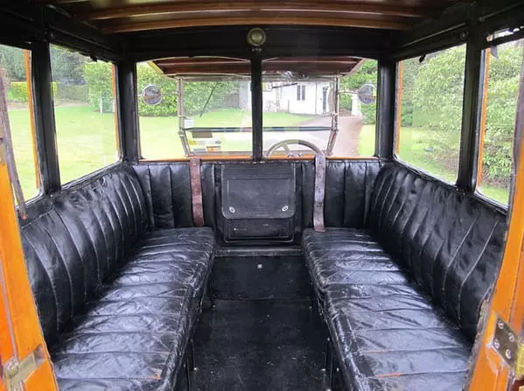













































































































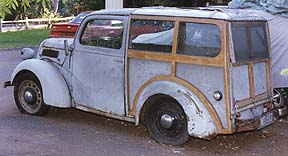
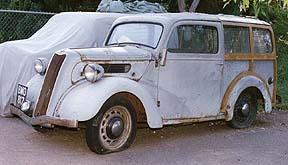
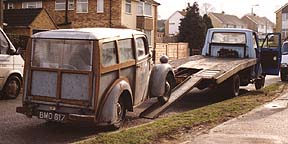


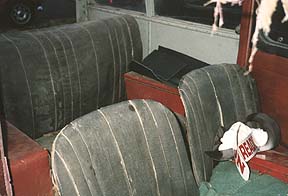






































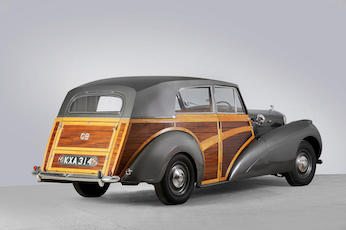


























Comments